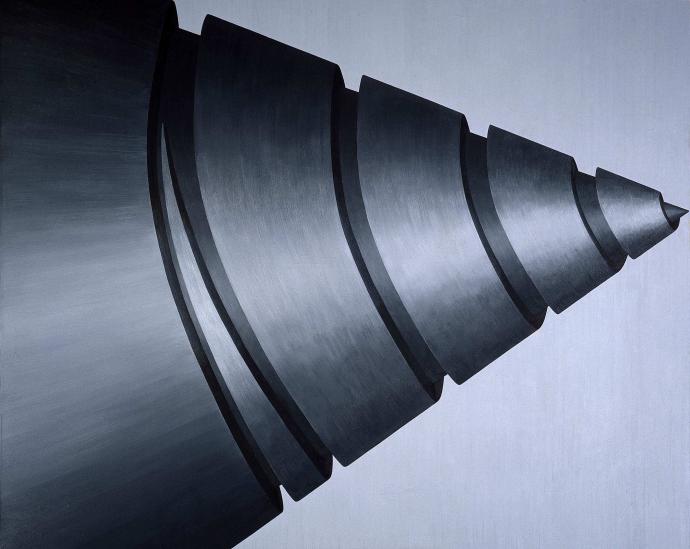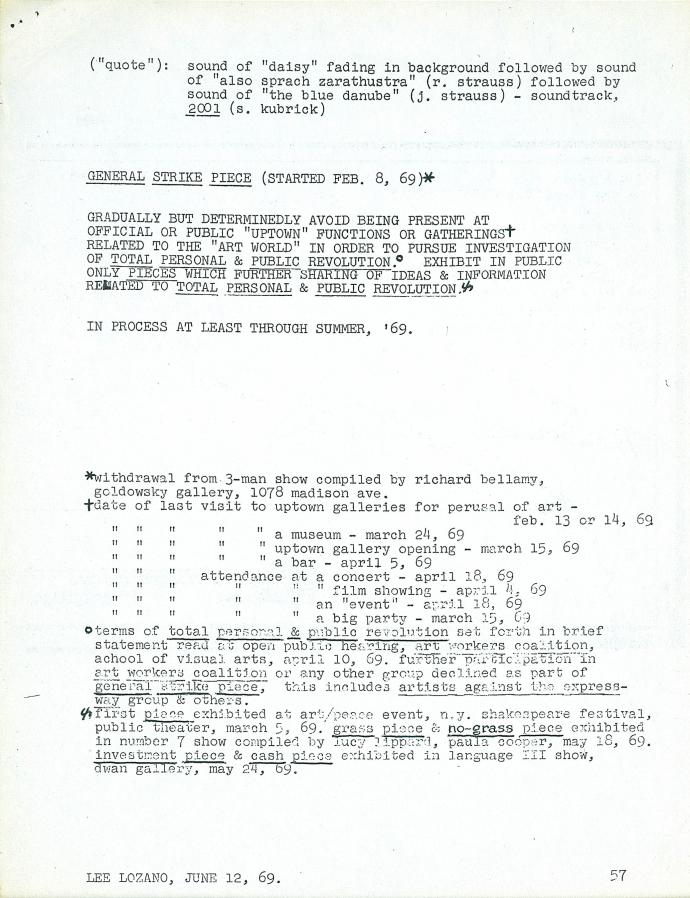from pastelegram.org, June 2011 – April 2014
Pun Value: Four Works by Lee Lozano
Pun Value, currently on view at the Blanton Museum of Art, displays four works from the museum’s collection by conceptual artist Lee Lozano. Accompanying the two monumental paintings Ream (1964) and Stroke (1967-1970), are a notebook study for Stroke and the well-known conceptual “art-life” work, General Strike Piece (1969). One goal of the show, according to its curator Katie Geha, is to represent Lozano’s diverse artistic output and avoid common readings of her work that reduce Lozano’s output to her biography. Pun Value asserts that, like the best puns, Lozano’s work is replete with multiple meanings.

Lee Lozano, Ream, 1964; oil on canvas; 198.1 cm x 243.8 cm; location in the Blanton Museum of Art, The University of Texas at Austin, Gift of Mari and James A. Michener in 1968; image courtesy the Blanton.
In General Strike Piece, Lozano limited her “art world” interactions through diaristic self-instructions. The typescript of General Strike Piece on display corresponds exactly to the handwritten original in Lozano’s personal notebook, where she wrote, “GRADUALLY BUT DETERMINEDLY AVOID BEING PRESENT AT OFFICIAL OR PUBLIC “UPTOWN” FUNCTIONS OR GATHERINGS RELATED TO THE “ART WORLD” IN ORDER TO PURSUE INVESTIGATION OF TOTAL PERSONAL & PUBLIC REVOLUTION.” A footnote written by Lozano attached to the statement above reads, “further participation in art workers coalition or any other group declined as part of general strike piece.” Recorded on June 12, 1969, both notebook and transcription indicate that she began the general strike process in early spring (“Started in Feb. 8, 69”) and intended to maintain it through the summer. Geha’s wall text for General Strike Piece explains that with this work, “Lozano literally went on strike, actively adopting a passive stance by removing herself from the art world.” Surely, Lozano’s General Strike Piece—its first iteration read aloud at an open hearing of the Art Workers’ Coalition on April 10, 1969—registers the artist’s frustration with the art world. But the verbal pun of “strike,” meaning both “to lash out and to withdraw,” reveals the flexibility of General Strike Piece and Lozano’s practice in general, as the wall text explains.
As it happens, Lozano did not totally withdraw from the art world during these months. In April of 1969 the artist began another “art-life” work, Dialogue Piece (alternatively titled Verball in natural accordance with her love of puns). In her notebook Lozano instructs herself, “CALL (OR WRITE/SPEAK TO) PEOPLE FOR THE SPECIFIC PURPOSE OF INVITING THEM TO YR LOFT FOR A DIALOGUE. IN PROCESS FOR REST OF “LIFE”.” Within two months she had written to, spoken with or was visited by Robert Morris, Walter de Maria, Jasper Johns, Larry Poons, Yvonne Rainer, Claus Oldenburg, Michael Heizer, Ian Wilson, Brice Marden, Lawrence Weiner, Richard Serra, Dan Graham, Robert Smithson and Marcia Tucker (to name a few). Listing various dialogues and succinct descriptions of conversations in her notebook through the fall of 1969, Lozano diligently followed her own directive, even if it was one directly antithetical to what she outlined in General Strike Piece.

Lee Lozano, General Strike Piece, 1969; offset print; 28 cm x 21.5 cm; location in the Blanton Museum of Art, The University of Texas at Austin, Gift of Jaap van Liere in 2001; image courtesy the Blanton.
I don't mean to suggest the artist was not serious about withdrawing herself from the art world by pointing out the incongruities between Lozano’s self-instruction pieces. She did, in fact, withdraw fully from New York in late 1972 with another conceptual work, Drop Out Piece. But focusing solely on the multiple meanings of “strike” to illuminate General Strike Piece seems to limit a full interpretation of Lozano’s word play. This approach is not unfitting, because Lozano indeed worked from verb lists. In “All Verbs,” a notebook entry dated 1964/1967, Lozano includes “ream” and “stroke,” both of which act as the titles of—and possibly the basis for—the two paintings included in Pun Value.1 However, it seems more productive to me in the context of this exhibition to highlight that the term “general” might function as another pun in General Strike Piece. Understood as “approximately universal with implied limits” by the Oxford English Dictionary, 'general' emerges as the more equivocal term. “Generally” withdrawing from the “art world,” seems to have meant withdrawing only from uptown galleries, after all. The freshly-minted downtown galleries such as Paula Cooper, where Lozano appeared at openings in 1969, were within the implied limits of her general strike.2
Mincing aside, Pun Value reveals Lozano’s interest in process as both a conceptual artist and a painter, a point made clear in the paintings that the exhibition includes. In Stroke, Lozano maneuvers around the concept “stroke” to reveal a multiplicity of verbal meanings. Stroke as an action—such as a gesture or caress—can also be understood as an index or literal impression of an action.3

Lee Lozano, Stroke, 1967 - 1970; oil on canvas; 106.68 cm x 106.68 cm; location in the Blanton Museum of Art, The University of Texas at Austin, purchased through the generosity of The Judith Rothschild Foundation and the Michener Acquisitions Fund in 2001; image courtesy the Blanton.
Analogs of Stroke’s dual meanings emerge in the painting’s visual play. The diptych of two squares, one grey and one black, immediately foils the notion of a single stroke. A grey trapezoid comprised of smooth and wide diagonal strokes sweeps from upper right to lower left upon the light grey surface of the left-hand square. Like a cast shadow or gentle wash, the trapezoidal shape hovers on its halftone surface, subtly fading in color toward its right edge. The scarcely perceptible change in grey tones plays with the illusion of shading on a flat surface, since it’s not immediately clear if the tonal changes are the result of the gallery’s lighting. The subtle gradation of color evokes the transience of a shadow. Searching the illusionistic surface for signs of real or illusionistic shadow, the viewer cannot help but run her gaze up and down the trapezoid’s edges. Viewers thus enact a kind of visual stroking, and Lozano forces us into her own puns.
To the right, the black half of the diptych presents a complementary set of impressions that elects for the literal rather than the illusionistic. The arrangement of nine diagonal lines of ovoid cuts echoes the angle and width of the shape on the left grey canvas. This series of punctures—growing in length from top to bottom—reads as a single shape. Installed several inches away from the wall, per Lozano’s instructions, the light cast through these perforations interrupts the canvas’ rectangular shadow. By cutting into the taut surface of the canvas, Lozano extends the diagonal lines, rendering the shapes as both negative cuts in the canvas as well as positive strokes of light on the wall.
Stroke encourages the viewer to move towards and around the canvas to resolve the interplay between illusionistic surface and sculptural form. The titular cue prompts the viewer to engage in Lozano’s game; endlessly searching for strokes, one begins to understand the concept of word play and appreciate Lozano’s fascination with puns. Like Lozano herself, Stroke is a slippery work that thwarts a single reading.4 Stroke suggests, as do her “art-life” works, that Lozano considered fluidity the most fundamental conceptual structure in her artistic process.
- 1. The full list from her notebook reads: "All Verbs: ream, spin, veer, span, cross, ram, peel, charge, pitch, verge, switch, shoot, slide, cram, goad, clash, cleave, fetch, clamp, lean, swap, butt, crook, split, jut, hack, break, stroke, stop.”
- 2. In May of 1969 Lozano attended the opening of Lucy Lippard’s show, Number 7, at Paula Cooper Gallery. Lozano’s Grass Piece was among the works shown in the group exhibition, and many of her fellow contributors, such as Hans Haacke and Dan Graham, not to mention Lippard herself, were active members of the Art Workers' Coalition.
- 3. This definition of a stroke as an index of an action has dramatically evolved from its original meaning to signify a cerebrovascular accident today.
- 4. Even the notebook study for Stroke outlines only part of Lozano’s process. It specifies the measurements of the ovoid cuts, but on paper the lines slope horizontally across the grid.